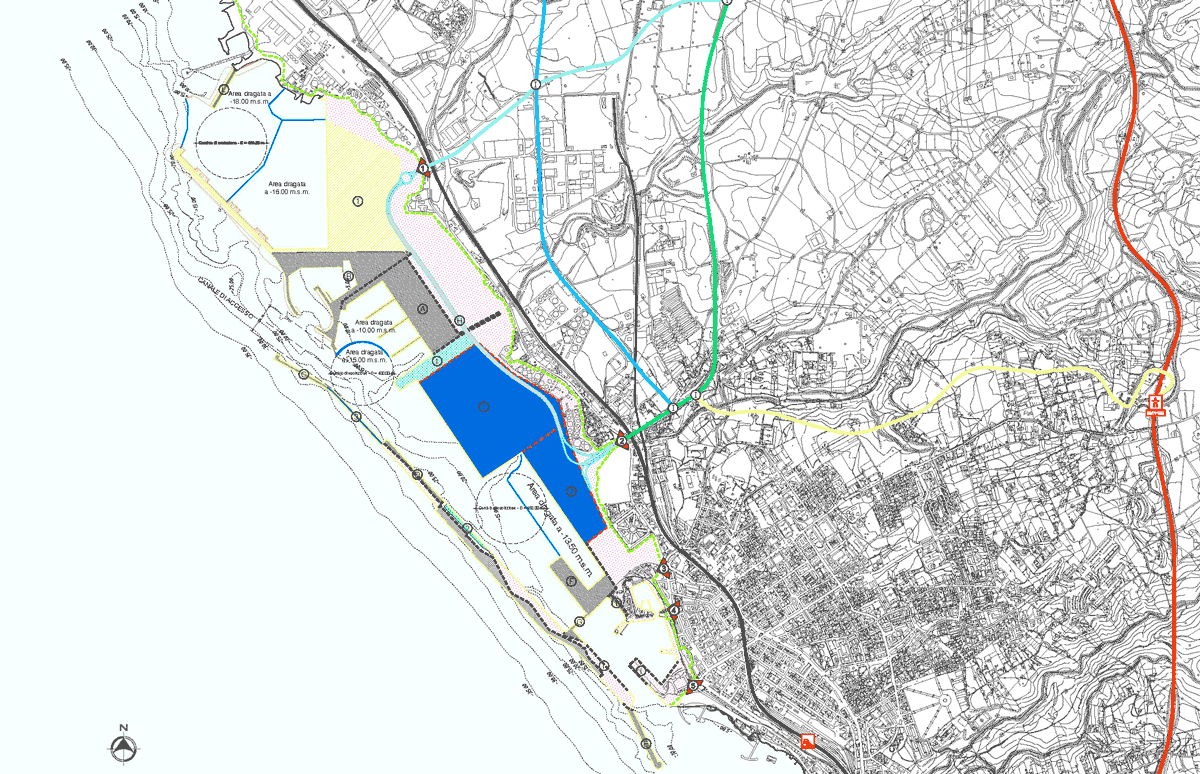Preliminary design and environmental impact study of the Strategic Works for the Port of Civitavecchia
Client: Port Authority of Civitavecchia
Period of implementation: —
Total value of works: Euro 150.837.740,69
Value of our services:: Euro —
Preliminary Design for Strategic Works
In 2003 pursuant to Law no. 443 of 21/12/2001 entitled “Delegation to the Government regarding strategic productive infrastructures and settlements and other interventions for the relaunching of productive activities”, the Civitavecchia Port Authority has identified the Strategic Works for the development of the Commercial Port. On 09/06/2003, pursuant to Legislative Decree 190/02, the Civitavecchia Port Authority sent the preliminary designs of the ten Strategic Works identified to the Higher Council of Public Works, communicated with the resolution of 185/2003 sent with Note Prot. no. 474 of 19/12/2003. On 04/06/2003, pursuant to the same Legislative Decree 190/02, the Port Authority sent to the Ministry for the Environment and the Protection of the Territory and the Sea, the Ministry for the Cultural Heritage and Cultural Activities and to Lazio Region the environmental impact study necessary for starting the evaluation procedure. In October 2004, pursuant to Law 21/12/2001 no. 443 and Legislative Decree 20/08/2002 no. 190, the Inter-Ministry Committee for Economic Planning (CIPE) started the procedure on the Port Hub of Civitavecchia, ending in December of the same year with a favourable opinion through the issue of a regulatory provision fully including the requirements contained in the opinions issued by the Ministry for the Environment and the Protection of the Territory and the Sea, the Ministry for the Cultural Heritage and Cultural Activities and Lazio Region.
The purpose of the Strategic Works is to favour the expected increase of seagoing traffic to allow the Port of Civitavecchia to become a port hub in the Tyrrhenian Sea. These works thus involve a substantial increase of the length of quays available, the optimization and the specialization of moorings and dedicated on-shore areas. The port layout resulting from the construction of the Strategic Works (as stated in the Port Planning Scheme approved by the Higher Council for Public Works with resolution no. 209 of 29/10/2004 and with Environmental Impact Assessment Decree no. 4 of 2010), provides for the definitive separation between the historic port, no longer suited to hosting commercial traffic because of the vicinity to the city centre, and the operational port, suited to hosting cruise ship, passenger and commercial traffic with its location outside the city and, above all, for the easier road and rail access it enjoys.
The Strategic Works identified are as follows:
- Ferry Dock, designated for use by cabotage traffic with the islands;
- Service Dock, designated for use by police forces, port services and the local fishing fleet;
- Extension of the breakwater of the C. Colombo detached mole, which provides the delimitation of the new port entrance, providing adequate protection of the Ferry Dock from wave action;
- Extension of quay no. 13, to increase mooring facilities for cruise ship traffic;
- New access to the historic harbour, with the second entrance to the Port allowing the definitive separation of seagoing traffic between historic port and operational port;
- New quays for the cruise ship and commercial area, aimed at increasing the length of the quays and the on-shore areas dedicated to this traffic;
- A mobile jetty connected with the Traianeo detached mole, aimed at guaranteeing the connection between the detached mole and land, thus allowing it to be utilized;
- Main dedicated port road network, necessary for guaranteeing the better distribution of vehicle traffic inside the operational port, equipped with dedicated entrances for each port area;
- Refitting the quays in the historic harbour, aimed at allowing utilization ensuring the respect of the high quality cultural heritage;
- Inner breakwater, to guarantee the better operation of the infrastructure.
Environmental impact study
The environmental impact study, drafted according to the technical regulations of Prime Minister’s Decree DPCM 27/12/88, was divided into the three sections described below.
Planning Framework: the verification of consistency was conducted with reference to the planning instruments currently in force. The analysis undertaken shows that the Strategic Works and the contents and aims of the port conversion deriving from them is not in contrast with the aforesaid instruments.
Project framework: description of the strategic measures, starting from the description of the main alternative solutions and the motivations behind the project.
Environmental framework: this framework was set up by selecting the components actually involved in the construction of the works and their functioning after completion. The environmental components examined during the study were as follows:
- Soil and subsoil
- Aquatic vegetation, flora, fauna and ecosystems
- Atmosphere and noise
- Landscape
- Non-technical summary.
With regard to the EIS (Environmental Impact Study), field studies were undertaken on the following aspects:
- Quality of the atmosphere;
- Noise level;
- Conditions of the soil, subsoil and water environment;
- Chemical and biological characteristics of the portion of marine environment off the stretch of coast concerned;
- Possible presence of historical and archaeological remains reported in bibliographical sources and/or discovered on the site;
- Characteristics of the landscape, also taking into account the measures implemented recently by various branches of the public administration and their planning policies.
The assessments undertaken lead to the conclusion that the planned works will provide a significant contribution to:
- strengthening the port’s role in Central Italy;
- improving the local economic and social conditions of population;
- renovation of the city centre and the surrounding urban area;
- improving urban quality;
- raising the level of land transport efficiency;
- streamlining urban vehicle traffic deriving from the separation of access to the Commercial Port and historic port.




